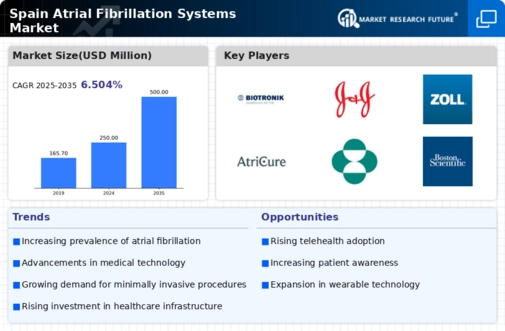The Spain Atrial Fibrillation Systems Market is characterized by its dynamic competitive landscape, driven by an increasing prevalence of atrial fibrillation and a growing demand for advanced medical technologies. With a focus on providing effective electrophysiological solutions, the market includes a variety of players that offer innovative products such as arrhythmia diagnostics, catheter ablation systems, and remote patient monitoring solutions. The competition among these companies is influenced by factors like technological advancements, regulatory approvals, and strategic partnerships aimed at enhancing product offerings.
Increasing investments in research and development and a rising emphasis on improving patient outcomes contribute to the competitive dynamics of this market, highlighting the critical role of innovation in capturing market share.Biotronik has established a notable presence in the Spain Atrial Fibrillation Systems Market through its commitment to cutting-edge technology and quality products.
The company is recognized for its robust range of cardiac devices, particularly its catheter-based solutions for treating atrial fibrillation. Biotronik's strengths lie in its innovative product offerings, including advanced ablation catheters and its focus on remote monitoring systems that enhance patient care and outcomes. The company has successfully positioned itself in the Spanish market by adhering to high regulatory standards and actively engaging with healthcare professionals to foster collaboration and product awareness.
This focus on relationships and quality has significantly bolstered Biotronik's reputation and market share in Spain.GE Healthcare plays an instrumental role in the Spain Atrial Fibrillation Systems Market by providing a broad spectrum of healthcare solutions, including advanced imaging systems and analytics tailored for cardiovascular applications.
The company's offerings encompass various diagnostic and monitoring tools, enabling precise detection and management of atrial fibrillation. GE Healthcare's strengths in Spain are underscored by its technological prowess, extensive distribution network, and collaborations with local healthcare providers to enhance care delivery. The company has focused on expanding its service capabilities and investing in research initiatives to innovate healthcare solutions tailored to the needs of the Spanish population. Its strategic mergers and acquisitions also enhance its position within the market, allowing for an integrated approach to addressing the complexities of atrial fibrillation management and promoting patient engagement through advanced digital platforms.













